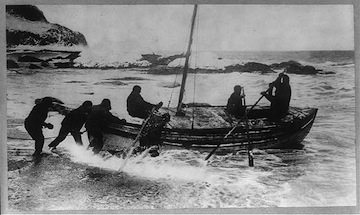331214-shackelton.jpg

Shackelton's crew in a lifeboat. Credit: Library of Congress
In May of 1916, three wretched men appeared at a whaling camp on South Georgia, a remote island in the South Atlantic. Exhausted, hungry, and frostbitten, the men had long since been given up for dead.Their expedition had set sail from England in late 1914. It was commanded by Sir Ernest Shackleton, who’d come close to the South Pole in 1909, as he explained:
“We reached a point within 97 geographical miles of the South Pole. The only thing that stopped us from reaching the actual point was the lack of 50 pounds of food.”
Roald Amundsen reached the pole two years later. So Shackleton decided the only challenge left was to cross the entire Antarctic continent from coast to coast.
Before he could reach Antarctica, though, his ship, the Endurance, became locked in the ice. After months of waiting, the ice crushed Endurance’s hull, so the men lived on the ice until it got too thin. They then spent a week sailing across stormy seas in lifeboats to Elephant Island. It was too remote to expect rescue, though, so Shackleton and five others headed across 800 miles of stormy seas to South Georgia.
They endured bitter cold and hurricane-force winds, and arrived at South Georgia after 17 days at sea. Shackleton and two of the men then hiked over rugged ice-covered mountains to reach the whaling camp.
It took months to return to Elephant Island, but the men there were safe. Every man in the Shackleton expedition survived.

